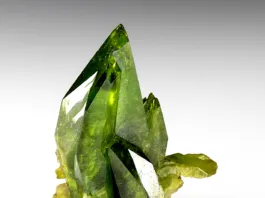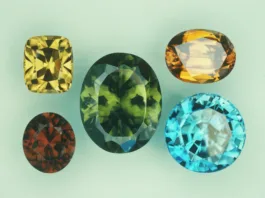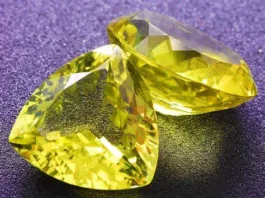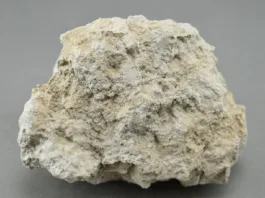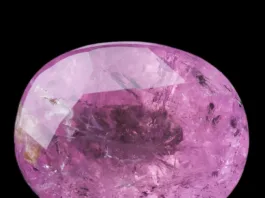Carborundum, also known as silicon carbide (SiC), is a crystalline compound composed of silicon and carbon. It was first discovered in the late 19th century and has since become an important material with various industrial applications. One particular form of carborundum is carborundite.


Carborundite refers to a synthetic compound of silicon carbide that is primarily used as an abrasive material. It is created through the process of combining silicon dioxide and petroleum coke at extremely high temperatures, typically in an electric resistance furnace. The resulting product is a hard, crystalline material with excellent hardness and thermal conductivity.
Due to its exceptional hardness, carborundite is widely used as an abrasive in applications such as grinding, cutting, polishing, and sanding. It is commonly utilized in the manufacturing and machining industries for tasks like sharpening tools, shaping and finishing metal surfaces, and removing unwanted material.
Carborundite’s hardness also makes it suitable for applications that require wear resistance and durability. It is employed in the production of wear-resistant parts, such as ceramic bearings, mechanical seals, and cutting tools. Additionally, carborundite is used in the production of refractory materials, which are capable of withstanding high temperatures and harsh environments. These refractories find application in industries such as metallurgy, ceramics, and glass manufacturing.
Another significant characteristic of carborundite is its high thermal conductivity. This property makes it valuable for thermal management applications, including heat sinks and electronic components that require efficient heat dissipation.
Furthermore, carborundite has found use in the field of electronics, particularly in the semiconductor industry. It is used as a substrate material for electronic devices and as an abrasive in the production of silicon wafers for semiconductors.
Overall, carborundite, with its exceptional hardness, thermal conductivity, and other desirable properties, plays a crucial role in numerous industrial applications. Its versatility and durability have made it an essential material for various manufacturing processes, contributing to the advancement of numerous industries.
Contents
Geological Formation of Carborandite
Carborundite, or silicon carbide, is not a naturally occurring mineral. It is a synthetic compound produced through industrial processes. However, silicon carbide does have natural counterparts that are formed through geological processes.
Natural silicon carbide minerals are typically found in certain types of metamorphic rocks, specifically in high-temperature and high-pressure environments. The most common natural form of silicon carbide is called moissanite, which is a rare mineral discovered in meteorites and found in limited quantities in certain regions of the Earth.
The geological formation of natural silicon carbide involves the following processes:
- Metamorphism: Silicon carbide forms under conditions of high temperature and pressure during metamorphic events. Metamorphism occurs when pre-existing rocks are subjected to intense heat and pressure deep within the Earth’s crust or during tectonic events such as mountain building.
- Carbon-rich Environments: Silicon carbide formation requires a carbon-rich environment. The presence of carbonaceous materials, such as graphite or organic matter, in the rocks undergoing metamorphism provides a source of carbon for the reaction.
- High-Temperature Reactions: Under high temperatures and pressures, silicon dioxide (SiO2) and carbonaceous materials react to form silicon carbide. This reaction can be represented by the chemical equation:SiO2 + 3C → SiC + 2COIn this reaction, silicon dioxide combines with carbon to produce silicon carbide and carbon monoxide gas.
- Crystallization: The newly formed silicon carbide crystallizes within the rock matrix as the temperature and pressure conditions allow. The resulting silicon carbide crystals can range in size and occur in various forms, depending on the specific conditions of formation.
It’s important to note that while natural silicon carbide minerals are found in geological formations, the industrial production of carborundite involves a different process. Synthetic carborundite is created by combining silicon dioxide and petroleum coke at extremely high temperatures in an electric resistance furnace. This synthetic production method allows for the controlled creation of carborundite with specific properties and compositions for various industrial applications.
Physical Properties of Carborandite
Carborundite, or silicon carbide (SiC), possesses several notable physical properties that make it valuable for various industrial applications. Here are some key physical properties of carborundite:
- Hardness: Carborundite is an extremely hard material. On the Mohs scale of mineral hardness, it has a hardness rating of 9-9.5, making it one of the hardest known substances. This hardness contributes to its excellent abrasive properties and wear resistance.
- Crystal Structure: Carborundite crystallizes in a variety of crystal structures, including hexagonal, rhombohedral, and cubic forms. The crystal structure influences the material’s physical and chemical properties.
- Color: The color of carborundite varies depending on impurities and crystal structure. Pure carborundite is usually colorless or appears as a pale yellow or greenish tint. Impurities can give it shades of blue, brown, or black.
- Density: The density of carborundite typically ranges from 3.0 to 3.2 grams per cubic centimeter (g/cm³). This relatively high density contributes to its solid and robust nature.
- Thermal Conductivity: Carborundite exhibits high thermal conductivity, meaning it efficiently conducts heat. This property makes it useful for applications where heat dissipation is crucial, such as heat sinks and electronic components.
- Melting Point: The melting point of carborundite is approximately 2,830 degrees Celsius (5,126 degrees Fahrenheit). Its high melting point enables it to withstand extreme temperatures, making it suitable for high-temperature applications.
- Electrical Conductivity: Carborundite can conduct electricity, but its conductivity is significantly lower than that of metals. It is considered a semiconductor material and finds application in the electronics industry, particularly in high-temperature and high-power devices.
- Chemical Stability: Carborundite is highly chemically stable, especially at high temperatures. It is resistant to acids, alkalis, and oxidation, which makes it suitable for use in harsh chemical environments.
These physical properties of carborundite contribute to its wide range of applications, including abrasives, refractories, semiconductor devices, ceramics, and more. Its hardness, thermal conductivity, and stability make it a versatile material capable of withstanding demanding conditions.
Occurrence and Distribution of Carborandite
Carborundite, or silicon carbide (SiC), does not occur naturally in significant quantities. It is primarily a synthetic compound produced through industrial processes. However, natural silicon carbide minerals do exist in limited quantities and are known as moissanite.
Moissanite is a rare mineral that was first discovered in 1893 in a meteorite crater in Arizona, United States. It is also found in other meteorites and has been identified in a few terrestrial locations. However, natural moissanite is extremely scarce and does not occur in large enough quantities for significant industrial use.
As for synthetic carborundite, it is produced worldwide in large quantities for industrial applications. The manufacturing process involves combining silica (silicon dioxide) and petroleum coke at high temperatures in electric resistance furnaces. Synthetic carborundite can be tailored to specific requirements, such as particle size, purity, and composition, making it suitable for various industries.
The distribution of carborundite production facilities is widespread, with manufacturing plants located in different countries across the globe. Major producers include the United States, China, Russia, and countries in Europe.
While natural moissanite is rare and not commercially significant, the synthetic production of carborundite ensures a stable and reliable supply for industrial purposes. Its versatility and desirable properties have led to its wide application in industries such as abrasives, refractories, electronics, ceramics, and more.
Petrogenesis of Carborandite
Carborundite, or silicon carbide (SiC), is not a mineral that forms through typical petrogenetic processes. It is a synthetic compound produced industrially by combining silica (silicon dioxide) and petroleum coke at high temperatures.
In natural geologic settings, silicon carbide can form as a mineral known as moissanite, but its occurrence is extremely rare and typically associated with meteorite impacts. Moissanite is not a product of typical petrogenesis or rock-forming processes.
Petrogenesis refers to the formation and evolution of rocks through geological processes. The formation of rocks involves various processes such as crystallization from magma or lava, sedimentation and lithification of sediments, and metamorphism under high temperatures and pressures. These processes give rise to the diverse range of minerals and rocks found in the Earth’s crust.
However, carborundite, as a synthetic compound, is not a product of natural petrogenesis. It is specifically manufactured through an industrial process that involves the combination of silica and petroleum coke in electric resistance furnaces at high temperatures.
Therefore, the petrogenesis of carborundite lies in its synthetic production rather than in natural geologic processes.
Geological Significance and Research Applications
While carborundite, or synthetic silicon carbide (SiC), does not have direct geological significance in terms of its natural occurrence, it does have important applications and research implications in the field of geology. Here are a few ways in which carborundite is significant in geology:
- Laboratory Experiments: Carborundite is used as an abrasive material in laboratory settings for cutting, grinding, and polishing geological samples. It allows geologists to prepare thin sections of rocks and minerals for microscopic analysis, aiding in the study of their mineralogical composition, textures, and structures.
- High-Temperature and High-Pressure Experiments: Carborundite’s resistance to high temperatures and pressures makes it valuable for experimental studies simulating extreme geological conditions. Geologists can use carborundite as a material in high-temperature furnaces or pressure vessels to recreate and investigate geological processes such as metamorphism, magma generation, or deep Earth conditions.
- Refractory Materials: Carborundite’s ability to withstand high temperatures and its resistance to chemical reactions make it suitable for manufacturing refractory materials used in high-temperature industrial processes. These refractories find application in various geological industries, including metallurgy, ceramics, and glass production.
- Research on Meteorites: Natural moissanite, a rare form of silicon carbide found in meteorites, has significant implications for studying extraterrestrial materials and planetary processes. Research involving the analysis of moissanite grains helps scientists understand the formation and evolution of meteorites, the early solar system, and the conditions in which they originated.
- Semiconductor and Electronics Research: Carborundite is a valuable material in the field of semiconductor research. Its properties, such as high thermal conductivity and wide bandgap, make it suitable for electronic devices and high-power applications. Researchers explore the potential of carborundite in developing advanced electronic components and power devices for various applications, including geophysical instrumentation and environmental monitoring.
It’s important to note that carborundite’s significance in geology primarily lies in its use as an experimental material and its contributions to scientific research rather than its natural occurrence. Its properties and applications enable geologists and researchers to study geological processes, simulate extreme conditions, and investigate various aspects of Earth and planetary sciences.
Uses
Carborundite, or silicon carbide (SiC), has a wide range of applications across various industries due to its unique properties. Here are some of the main uses of carborundite:
- Abrasives: Carborundite is widely used as an abrasive material. Its extreme hardness makes it effective for cutting, grinding, and polishing hard surfaces. It is utilized in abrasive products such as grinding wheels, sandpapers, and abrasive powders for metalworking, stone cutting, and surface finishing applications.
- Refractories: Carborundite’s high temperature resistance and chemical stability make it valuable for manufacturing refractory materials. These materials are used in industries where high temperatures and harsh conditions are encountered, such as in furnaces, kilns, and reactors for metal smelting, glass production, and cement manufacturing.
- Ceramics: Carborundite is employed in the production of advanced ceramics. Its high hardness, thermal conductivity, and resistance to heat and chemical corrosion make it suitable for manufacturing ceramic components used in high-temperature environments, electrical insulation, and wear-resistant applications.
- Semiconductor Devices: Carborundite’s semiconductor properties, including its wide bandgap and high-temperature stability, make it valuable in the production of semiconductor devices. It is used in power electronics, high-voltage rectifiers, and high-frequency applications. Carborundite-based devices are utilized in areas such as energy conversion, electric vehicles, and renewable energy systems.
- Heat Dissipation: Due to its excellent thermal conductivity, carborundite is used in heat sinks and heat exchangers for efficient heat dissipation. It helps dissipate heat generated by electronic components, such as computer chips, power modules, and LED devices.
- Wear-resistant Parts: Carborundite’s hardness and resistance to wear and abrasion make it suitable for manufacturing wear-resistant parts. It is used in the production of mechanical seals, bearings, cutting tools, and other components that require high durability and resistance to wear.
- Environmental and Energy Applications: Carborundite is utilized in various environmental and energy-related applications. It is used in catalytic converters for reducing emissions from vehicles, as a filter media in water treatment systems, and in solar energy systems for its optical properties and durability.
- Research and Development: Carborundite is employed in laboratories and research facilities for experiments, simulations, and studies involving high temperatures, extreme pressures, and material testing. It serves as a material for geological research, high-temperature experiments, and other scientific investigations.
These are just a few examples of the diverse applications of carborundite. Its unique combination of hardness, thermal conductivity, chemical stability, and semiconductor properties make it a valuable material in industries ranging from manufacturing and electronics to energy and environmental sectors.
Summary of key points
- Carborundite is a synthetic form of silicon carbide, not a naturally occurring mineral.
- It is produced by combining silica (silicon dioxide) and petroleum coke at high temperatures in electric resistance furnaces.
- Carborundite is primarily used as an abrasive material for grinding, cutting, polishing, and sanding.
- Its exceptional hardness, with a Mohs hardness rating of 9-9.5, makes it suitable for wear-resistant applications.
- Carborundite has high thermal conductivity, making it valuable for thermal management applications such as heat sinks.
- It is resistant to chemicals, acids, alkalis, and oxidation, providing stability in harsh environments.
- Carborundite finds applications in various industries, including manufacturing, machining, electronics, ceramics, and refractories.
- Natural silicon carbide minerals, known as moissanite, are extremely rare and mainly found in meteorites.
- Carborundite’s synthetic production allows for controlled properties and compositions tailored to specific industrial needs.
- It is used in laboratory experiments, high-temperature and high-pressure research, refractories, semiconductor devices, and wear-resistant parts.
- Carborundite has significance in geology for studying rocks and minerals, simulating extreme conditions, and investigating meteorites and planetary processes.
- Its unique combination of properties makes it valuable for a wide range of applications in various industries.
FAQs
- What is carborundite?
Carborundite, also known as silicon carbide (SiC), is a synthetic compound produced by combining silica (silicon dioxide) and petroleum coke at high temperatures. It is primarily used as an abrasive material and has various other industrial applications.
- Is carborundite a naturally occurring mineral?
No, carborundite is not a naturally occurring mineral. It is a synthetic compound created through industrial processes. However, natural silicon carbide minerals, such as moissanite, do exist in limited quantities.
- What are the main properties of carborundite?
Carborundite is known for its extreme hardness (Mohs hardness of 9-9.5), high thermal conductivity, chemical stability, and resistance to wear and abrasion. It also has semiconductor properties and can withstand high temperatures and harsh environments.
- What are the applications of carborundite?
Carborundite is used as an abrasive material in grinding, cutting, and polishing applications. It is also used in refractories, ceramics, semiconductor devices, heat sinks, wear-resistant parts, and various other industrial applications.
- How is carborundite manufactured?
Carborundite is manufactured by heating a mixture of silica and petroleum coke in electric resistance furnaces at high temperatures. The reaction between the two materials results in the formation of silicon carbide.
- Is carborundite toxic or hazardous?
Carborundite itself is generally considered to be inert and non-toxic. However, during manufacturing processes, exposure to dust or particulate matter should be avoided, as inhalation of fine particles may cause respiratory irritation.
- Can carborundite be recycled?
Yes, carborundite can be recycled. It can be processed and reused in various applications, such as the production of new abrasive products or as a component in refractories and ceramics.
- What are the alternatives to carborundite?
Some alternatives to carborundite as an abrasive material include aluminum oxide, diamond, and cubic boron nitride (CBN). The choice of abrasive material depends on the specific application and desired characteristics.
- Are there any environmental concerns associated with carborundite?
Carborundite itself is chemically stable and does not pose significant environmental concerns. However, the manufacturing process may involve energy-intensive operations, and proper waste management and emission control measures need to be implemented to minimize environmental impacts.
- Can carborundite be used in jewelry?
While carborundite itself is not commonly used in jewelry, its natural counterpart, moissanite, is used as a gemstone. Moissanite, a naturally occurring silicon carbide mineral, possesses optical properties that make it suitable as a diamond substitute in jewelry.

